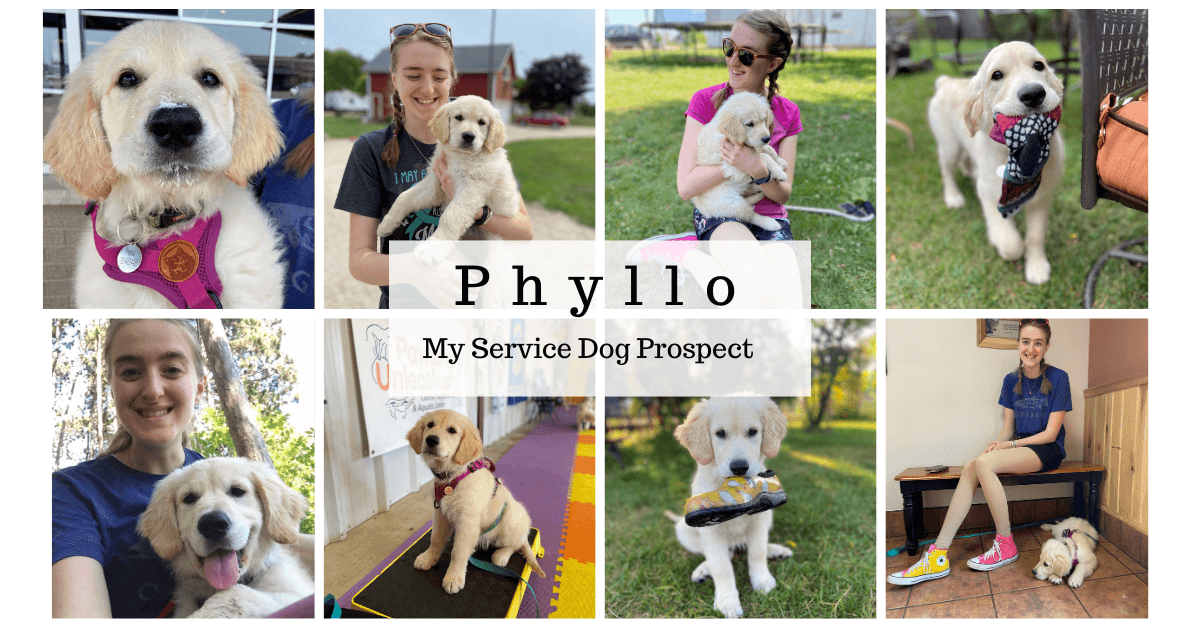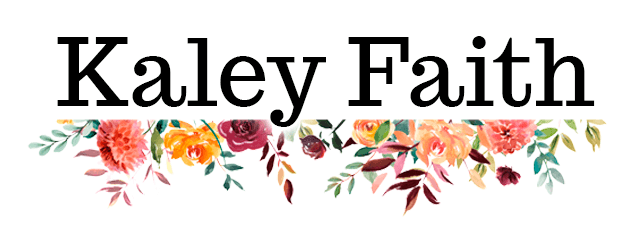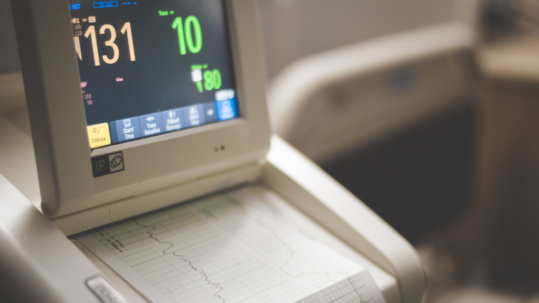
27 Aug Phyllo – My Service Dog Prospect
As I’m sure you can understand, getting a puppy didn’t seem like a great idea when considering the reality of potty breaks, playtime, and the general activity needed to keep up with a four-pawed toddler. Especially as it pertained to me and my physical and mental health limitations with POTS, persistent migraines, and a bouquet of mental health disorders. But one conversation in particular would have made for superb foreshadowing, had my life been a novel: “I am planning to get a dog, but don’t worry Mom and Dad – I won’t be getting a puppy. I will either wait for a program dog from an organization, or I’ll get an adult dog so we can get straight to task training.”
With the fancy movie editing, the scene then cuts to 3 days later as me and Mom are driving across the state to meet a 9-week-old pup the size of a tater tot, who would soon become my service dog prospect.
#Classic.
My Pup
Phyllo (pronounced Fee-low, as in, phyllo dough in baklava) is an English cream golden retriever puppy. As of the writing of this article, she is 3.5 months old and is an absolute delight. It was her wonderful temperament (and those of her fantastic parents) that solidified our decision, as she is calm, easygoing, observant, social, and food-motivated. Even after our first two weeks with her, she was already sleeping through the night and hadn’t had a SINGLE accident! I could not have been more grateful!
And while getting a puppy with POTS seemed impossible, there are a few quick reasons why it was a GREAT decision:
First, getting a puppy keeps me active. The first several weeks of having her I was in a perpetual state of awe as I saw just how much my body was actually capable of, despite my limitations. I quickly learned that whether I mope around the house or keep active with a puppy, having POTS sucks so I may as well stay active. Therefore, having a little cutie franticly whine “I NEED TO PEEEE!” beautifully lends itself to “sucking it up” and doing the thing. I often hit my point of exhaustion (like when my legs started violently shaking as I stood getting Phyllo’s harness on or when my heart rate hit 130 bpm as we played a calm game of fetch) but each day builds upon the last, and my physical therapist agrees – I am certainly better off for it.
Second, it gets me outside. Suddenly I am spending 5-6 hours a day barefoot in the great outdoors (thank you, Dad, for fencing in our backyard!). Whether I am sitting in the shade, soaking up sunshine on the porch, or sitting on the lawn playing fetch, being outside is grounding, and good.
Third, it gives me short-term goals. After backing out of nearly all of my commitments due to the unpredictability and severity of my symptoms, I was overall discouraged and resisted making any plans at all for fear of disappointing myself and others. But having Phyllo means that each day, there are things to do and there is progress to be made. My parents are incredibly supportive, and when I’m having a hard time they tag in. But whether its a good day or a flare day, I’m stuck with the pupper, and the relentless responsibility is a good thing.
Fourth, it gives me long-term goals. Not only does each day hold a series of small victories like teaching “sit,” giving her a bath, and meeting the neighbor dog, but Phyllo herself represents a long-term goal. In one year, it is my goal to be a fledgling “team” (a handler + trained service dog). With that goal, comes socializing, sensitizing, classes, training, and day-to-day animal husbandry which are all things that I am able to think about, research, and plan. With everything else in life, it is hard to look to the future because I do not yet know the outlook for the medical diagnoses and treatments I am yet to receive. In one year, I do not know if I will be able to work, drive, or live on my own, and yet I DO know that regardless of what happens (barring tragedy), Phyllo will be my steady sidekick. And for that, I am grateful.
Why Did I Seek a Service Dog?
Physically and medically, I have a long road ahead. With the addition of a fourth mental health diagnosis, I realize that recovery will likely be more “ongoing” than actually coming to a place of full resolution. Additionally, I have learned that treating POTS was not as easy as I thought it would be. I had relative success with metoprolol, however, even when it was working I found myself having scary blood pressure drops (like 79/40 mmHg – yikes!), and as I neared the end of its half-life my heart rate often soared. Ultimately, I had to be taken off it (and two other similar drugs) because of adverse reactions. So as I looked at my life with fresh eyes, I found that my physical and mental limitations continued to keep me from driving, cooking, working, and living on my own, and also made things like going to church, shopping, and sleeping quite difficult.
The Americans with Disabilities Act (ADA) defines a disabled person as:
“An individual with a disability is defined by the ADA as a person who has a physical or mental impairment that substantially limits one or more major life activities, a person who has a history or record of such an impairment, or a person who is perceived by others as having such an impairment.”
I genuinely hope that one day I do not meet this criteria, but today is not that day. No matter which way I proceed, it will likely take years to rebuild the resiliency and independence needed to live life in a sustainably robust manner. And one thing that can notably aid in that journey is a service dog.
Earlier this year I took some time to reassess my need after a “failed” attempt with my first prospect, Goose. I had been in weekly counseling for almost a year and was still really struggling with the overwhelming nature of my internal environment and an increasing struggle with going to normal places (church, grocery store, etc) for both mental and medical reasons. I was very grateful to have my childhood dog as emotional support but I was still trying to figure out if a designated task-trained service dog was right for me. As I talked through my hesitations, my counselor gave his thoughts: “I think getting a service dog would be a very good thing for you. For many reasons.”
I was crippled by the “what-if” questions. What if I’m a terrible dog trainer/handler? What if I don’t bond with the dog? What if I get totally healed in a day and then don’t need a service dog after all (an uncommon, but genuine thought/concern)? For each worst-case scenario, he helped me problem-solve practical solutions that immediately helped put things in perspective. Leaving the office that day, I had pep in my step, and as I approached my Dad and sister, I announced in dramatic hyperbolic fashion “So Mr. Counselor says I HAVE to get a service dog.” I was grinning ear to ear, finally feeling the weight of the decision off my shoulders, and a renewed excitement for simply digging into the practical next steps.
In a letter for an application, he would later write: “I have encouraged and support Kaley’s acquisition of a service dog. I believe that a service dog will be vital to her managing and regulating her mental health and wellbeing.“
So with signed letters from both my counselor and my doctor in support of acquiring a task-trained dog (and the wholehearted support of my parents), I once again started applying to service dog organizations and joining many groups on Facebook to keep an eye out for available pups, to learn more about training, and to start getting familiar with the community.
Then one day, Phyllo’s sweet little face scrolled past my eyeballs through one of the groups, and I couldn’t seem to shake the intrigue. Again, this was all of 3 days after telling my parents that I was definitely NOT getting a puppy. But alas, her squishy face and fluffy fur prompted a message to the breeders, and upon learning more about her, we scheduled a road trip to meet her. With green lights all the way, we went for it.
What’s the Plan, Stan?
In terms of training, me and Phyllo have been attending weekly puppy classes to socialize with other puppies, and get a good foundation of communication. I’m learning how to train, and Phyllo is learning how to listen. We have also met with a local trainer who has experience with service dogs, and is willing to work with us to accomplish this goal. Phyllo will be going to him for several weeks in order to maximize the socializing window and learn to be around dogs, people, and places while keeping her cool. After that, we’ll do private lessons each week to establish basic obedience, public access, and task training. While every dog is wildly different, it is my soft goal for us to be a “team” starting in the spring/summer (once she is over 1 year old), knowing that she may not be fully trained until around 2-3 years old.
Summary
I keep telling people, “Getting Phyllo is the best decision I’ve ever made for my physical and mental health,” and she is still just a puppy. But as I wait for tests and appointments that will likely bring definitive action/treatment (one week at Mayo Clinic in October! Can’t wait!), I am so grateful for her as a daily distraction and companion in the meantime. I look forward to the day she is my everyday/everywhere support, and until then I will cherish the small victories and soak in the puppy snuggles while being grateful for the support of my parents that makes this all possible.
P.S. Follow along as Phyllo grows up with our Instagram @faith.fluff.phyllo
-
Making a Full Physical Recovery – A Day-by-Day Miracle
“You should exercise more.” A brutal statement. One I had tried to fulfill on my own, and time and time again, had failed. It was a frustrating piece of advice from my doctor, and felt so out of reach as I navigated my bouquet of chronic illnesses....
27 June, 2024 No comment -
Awesome Recovery News!! And Why I No Longer Plan To Write About My Symptoms
I am so excited to report that after graduating from the 3-week Pain/Symptom Rehabilitation Center at Mayo Clinic in Rochester and continuing the program at home, I am nearly 100% recovered!...
05 March, 2024 3 Comments -
What is the Valsalva Maneuver like?
The Valsalva maneuver is EASILY the most fascinating thing I’ve gotten to do in this entire medical adventure. On the surface, it’s a fairly quick and easy part of autonomic testing, but underneath, it’s one of the coolest and most complicated mechanisms of the human body that I’ve encountered. ...
17 January, 2024 3 Comments






Pingback:PUPS, POTS, and PTSD - My Journey - Kaley Faith
Posted at 15:24h, 27 August[…] {Goose didn’t quite make it as a service dog candidate, read more about our journey here or meet my new prospect here.} […]
Pingback:Service Dogs - Temperament, Training, and a Goose Update - Kaley Faith
Posted at 15:30h, 27 August[…] {Edit: Meet my new prospect here!} […]
Pingback:5 Practical Tips for Physical Therapy with POTS - Kaley Faith
Posted at 19:24h, 13 October[…] My body is slowly rising up to meet the demands of living a healthy life (like keeping up with my puppy!), and I very much look forward to seeing how additional treatment enables me to further engage […]